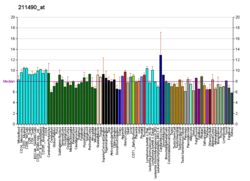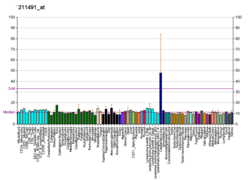Top Qs
Timeline
Chat
Perspective
Alpha-1A adrenergic receptor
Protein-coding gene in the species Homo sapiens From Wikipedia, the free encyclopedia
Remove ads
The alpha-1A adrenergic receptor (α1A adrenoreceptor), also known as ADRA1A, formerly known also as the alpha-1C adrenergic receptor,[5] is an alpha-1 adrenergic receptor, and also denotes the human gene encoding it.[6] There is no longer a subtype α1C receptor. At one time, there was a subtype known as α1C, but it was found to be identical to the previously discovered α1A receptor subtype. To avoid confusion, the naming convention was continued with the letter D.
Remove ads
Receptor
There are 3 alpha-1 adrenergic receptor subtypes: alpha-1A, -1B and -1D, all of which signal through the Gq/11 family of G-proteins. Different subtypes show different patterns of activation. The majority of alpha-1 receptors are directed toward the function of epinephrine, a hormone that has to do with the fight-or-flight response.
Gene
This gene encodes the alpha-1A-adrenergic receptor. Alternative splicing of this gene generates four transcript variants, which encode four different isoforms with distinct C-termini but having similar ligand binding properties.[6]
Ligands
Agonists
- 6-(5-fluoro-2-pyrimidin-5-yl-phenyl)-6,7-dihydro-5H-pyrrolo[1,2-a]imidazole: EC50 = 1nM, Emax = 65%; good selectivity over α1B, α1D and α2A subtypes[7]
- further partial agonistic imidazole compounds[8][9]
- A-61603[10]
- Metaraminol
Antagonists
- Tamsulosin: for treatment of benign prostatic hyperplasia
- Silodosin: for treatment of benign prostatic hyperplasia
- Doxazosin: for treatment of benign prostatic hyperplasia and/or Hypertension
- Risperidone: used to treat schizophrenia and bipolar disorder
- WB-4101
- Ziprasidone
- Nicergoline
- Most tricyclic antidepressants
Role in neural circuits
α1A-adrenergic receptor subtypes increase inhibition at dendrodendritic synapses, suggesting a synaptic mechanism for noradrenergic modulation of olfactory driven behaviors.[11]
See also
References
External links
Further reading
Wikiwand - on
Seamless Wikipedia browsing. On steroids.
Remove ads







